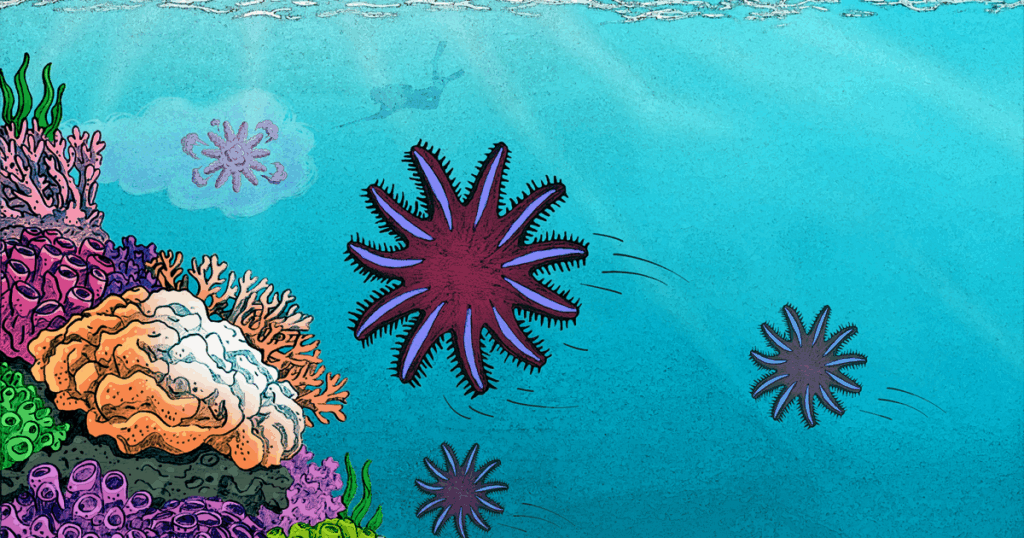
The Crown-of-Thorns Starfish (Acanthaster; CoTS), a native species to the reefs of the Indo-Pacific, has long been a paradoxical presence in marine ecosystems. While they play a crucial role in maintaining ecological balance, their potential for destruction during population outbreaks poses a significant threat to coral reefs. Recent research has unveiled a groundbreaking discovery that could revolutionize the way these outbreaks are managed, potentially saving vast stretches of coral from devastation.
A single CoTS can consume up to 240 cm2 of coral tissue daily, amounting to approximately 10 m2 each year. This might seem manageable, but during outbreaks, swarms of thousands can decimate hectares of coral in mere months. This overconsumption not only depletes the hard-bodied, reef-building corals essential for reef health and stability but also undermines the long-term resilience of these ecosystems against climate change.
New Approach to Pest Management
Traditionally, the primary method of controlling CoTS outbreaks has been manual culling, a process that is both labor-intensive and costly. However, a collaborative team of researchers from the Australian Institute of Marine Science (AIMS), the University of the Sunshine Coast, and the Okinawa Institute of Science and Technology (OIST) has made a promising breakthrough. They discovered that CoTS use their characteristic spines to detect peptides, allowing them to communicate with each other outside of mating seasons.
Building on this discovery, the researchers developed a synthetic peptide that can attract CoTS at very low concentrations without any toxic effects. This finding, published in iScience, could lead to the creation of potent pest-management peptides, termed Acanthaster attractins, which could efficiently gather CoTS in one location for removal.
Scientific Insights and Implications
Professor Noriyuki Satoh, head of the Marine Genomics Unit at OIST, elaborated on the findings:
“Through genomic and proteomic analysis, we found that the CoTS spines are used to both sense and secrete a wide range of peptides – not just defensive toxins. These may promote swarming, and so we synthesized the peptides that we suspected function like pheromones for communication and found that they consistently affect the trajectories of the starfish. With these attractins, we hope to contribute to the development of an efficient and safe measure against CoTS outbreaks.”
This discovery represents a significant shift in the approach to managing CoTS populations. By leveraging the starfish’s natural communication mechanisms, researchers aim to develop a more efficient and environmentally friendly method of pest control. The potential to attract and remove large numbers of CoTS simultaneously could drastically reduce the time and resources required for management efforts.
Historical Context and Future Prospects
The announcement comes as coral reefs worldwide face unprecedented threats from climate change, pollution, and overfishing. Historically, CoTS outbreaks have been linked to human activities such as nutrient runoff from agriculture, which promotes algal blooms that provide food for juvenile starfish. This new method of control could help mitigate one of the many pressures on these vital ecosystems.
Meanwhile, the broader implications of this research extend beyond the immediate goal of controlling CoTS populations. The understanding of peptide communication in marine species could open new avenues for ecological management and conservation strategies. With coral reefs supporting approximately 25% of all marine species, their preservation is critical to maintaining ocean biodiversity.
Looking forward, the development of Acanthaster attractins could serve as a model for similar pest management strategies in other marine environments. As researchers continue to refine these peptides, the hope is that they will provide a scalable and sustainable solution to one of the most pressing challenges facing coral reefs today.
The move represents a promising step toward safeguarding coral reefs, ensuring they continue to thrive in the face of mounting environmental challenges. As the research progresses, the potential for wider application and integration into existing conservation efforts remains a beacon of hope for marine ecosystems worldwide.





